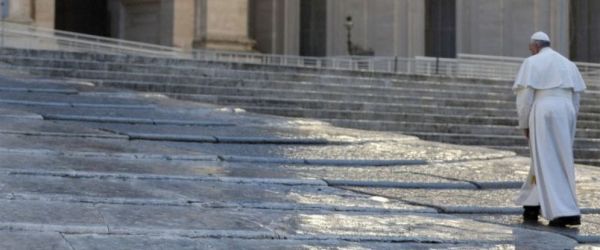This Sunday's Gospel passage (see Mt 14:22-33) speaks of Jesus walking on the water of the stormy lake. After feeding the crowds with five loaves and two fish – as we saw last Sunday – Jesus commands the disciples to get into the boat and return to the other shore. He dismisses the people and then climbs the hill, alone, to pray. He immerses Himself in communion with the Father.
During the crossing of the lake by night, the disciples' boat is hindered by a sudden wind storm. This is normal on a lake. At a certain point, they see someone walking on the water, coming toward them. Upset, they think it is a ghost and cry out in fear. Jesus reassures them: “Take heart, it is I; have no fear”. Then Peter – Peter who was so decisive – answers: “Lord, if it is you, bid me come to you on the water”. A challenge. And Jesus tells him: “Come”. Peter gets out of the boat and takes a few steps; then the wind and waves frighten him and he begins to sink. “Lord, save me”, he cries, and Jesus grasps him by the hand and says to him: “O man of little faith, why did you doubt?”.
This Gospel narrative is an invitation to abandon ourselves trustingly to God in every moment of our life, especially in the moment of trial and turmoil. When we have strong feelings of doubt and fear and we seem to be sinking, in life’s difficult moments where everything becomes dark, we must not be ashamed to cry out like Peter: “Lord, save me” (v. 30). To knock on God’s heart, on Jesus’s heart. “Lord, save me.” It is a beautiful prayer! We can repeat it many times. “Lord, save me.” And Jesus’s gesture, who immediately reaches out His hand and grasps that of His friend, should be contemplated at length: this is Jesus. Jesus does this. Jesus is the Father’s hand who never abandons us, the strong and faithful hand of the Father, who always and only wants what is good for us. God is not in the loud sound, God is not the hurricane, He is not in the fire, He is not in the earthquake – as the narrative about the Prophet Elijah also recalls today that says God is the light breeze – literally it says this: He is in the “ thread of melodious silence” – that never imposes itself, but asks to be heard (see 1 Kgs 19:11-13). Having faith means keeping your heart turned to God, to His love, to His Fatherly tenderness, amid the storm. Jesus wanted to teach this to Peter and the disciples, and also to us today. In dark moments, in sad moments He is well aware that our faith is weak –all of us are people of little faith, all of us, myself included, everyone – and that our faith is weak our journey can be troubled, hindered by adverse forces. But He is the Risen One! Let’s not forget this: He is the Lord who passed through death in order to lead us to safety. Even before we begin to seek Him, He is present beside us lifting us back up after our falls, He helps us grow in faith. Maybe in the dark, we cry out: “Lord, Lord!” thinking He is far away. And He says, “I am here.” Ah, He was with me! That is the Lord.
The boat at the mercy of the storm is the image of the Church, which in every age encounters headwinds, very harsh trials at times: we recall certain long and ferocious persecutions of the last century and even today in certain places. In situations like that, she may be tempted to think that God has abandoned her. But in reality it is precisely in those moments that the witness of faith, the witness of love, the witness of hope shines the most. It is the presence of the Risen Christ in His Church that gives the grace of witness unto martyrdom, from which buds new Christians and fruit of reconciliation and peace for the entire world.
May the intercession of Mary help us to persevere in faith and fraternal love when the darkness and storms of life place our trust in God in crisis.
[Pope Francis, Angelus, 9 August 2020]












